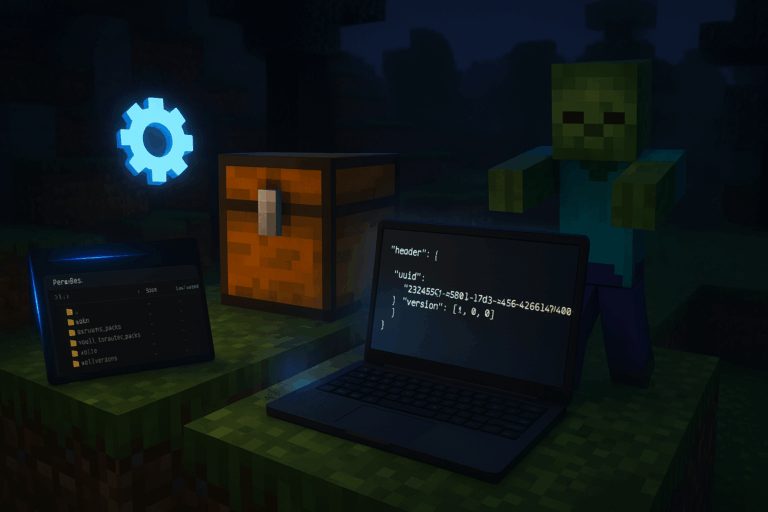
Ready to add new mechanics, mobs, or rules to your Bedrock server? Let’s install a behavior pack cleanly, no guesswork. Need stability? Check our optimized Minecraft hosting.
.mcpack, .mcaddon, or .zipmanifest.json.mcpack or .mcaddon, rename it to .zip to inspect (e.g., MyPack.mcpack → MyPack.zip). Extract it and ensure the folder contains manifest.json directly (not nested one level deeper). If needed, fix the structure to MyPack/manifest.json. Zip the folder back to MyPack.zip for upload.
manifest.json. In the "header" section, note "uuid" (e.g., "123e4567-e89b-12d3-a456-426614174000") and the "version" array (e.g., [1,0,0]). Do not use the UUID from modules; you need the header.uuid. Keep these values handy, we’ll paste them into the world config.
behavior_packs (create it if missing). Click “Upload” to send MyPack.zip, then “Unarchive” to extract it. You should see MyPack/manifest.json; if you see MyPack/MyPack/manifest.json, fix the nesting.
/home/container/worlds/[WorldName]. Create world_behavior_packs.json if it doesn’t exist. Paste a JSON array entry like: [{"pack_id":"123e4567-e89b-12d3-a456-426614174000","version":[1,0,0]}]. Replace pack_id and version with your exact values; a single typo will break loading.
behavior_packs/MyPack/manifest.json. If you get dependency errors, the pack likely also needs a Resource Pack — we’ll add it next.
.mcpack/.mcaddon to import, then “Play” → “Create New World”. In “Behavior Packs”, enable the pack (and in “Resource Packs” if required by the creator). Create the world, load it once, then go back to the main menu.
World.mcworld file and keep it ready for upload.
/home/container/worlds/. Create a folder with your world name (e.g., BedrockWorld) and upload World.mcworld there. Rename it to World.zip and click “Unarchive”. Ensure the folder contains the expected Bedrock world files (e.g., db, pack references, etc.).
server.properties from the “Files” or “Config” tab. Set level-name= to the exact folder name (e.g., level-name=BedrockWorld). Save the file, go to “Console”, and click “Restart”. The server will now load that exported world with your activated packs.
resource_packs. Upload the resource pack to resource_packs and declare it in /home/container/worlds/[WorldName]/world_resource_packs.json like: [{"pack_id":"RESOURCE_UUID","version":[1,0,0]}]. Use the header.uuid and header.version from the resource pack’s manifest.json. Missing this often causes invisible items or dependency errors.
19132) and verify the new mechanics. If the pack doesn’t apply, re-check JSON syntax, the exact UUID, and version array. If you see “pack with id does not exist”, fix folder nesting or incorrect names. As a last step, remove the pack folder and JSON entry, restart, and reinstall carefully.
Back up world_behavior_packs.json before changes. Test in small batches (1–3 packs) to catch conflicts early. Track versions: update [major,minor,patch] when packs change. Use SFTP for files >100 MB to avoid timeouts. For complex packs, enable all required experiments in a local world, then export — it’s the most reliable path.
Open manifest.json and use header.uuid and header.version. Example: "uuid":"123e4567-e89b-12d3-a456-426614174000", "version":[1,0,0]. Don’t use modules UUIDs.
Ensure structure is behavior_packs/PackName/manifest.json (no double nesting). Validate JSON (brackets, commas, quotes). Match the exact UUID and version, restart the server, and check console logs for dependency hints.
Add multiple objects in the array inside world_behavior_packs.json, separated by commas. Example: [{"pack_id":"UUID1","version":[1,0,0]},{"pack_id":"UUID2","version":[2,3,1]}]. Restart to apply.
You’ve got this. Go step by step, test after each change, and your Bedrock server will run custom mechanics like a champ.